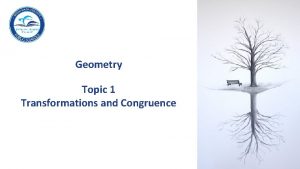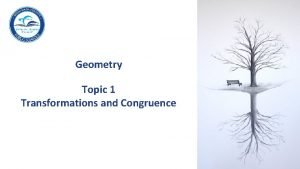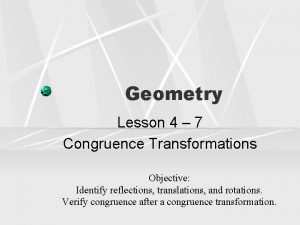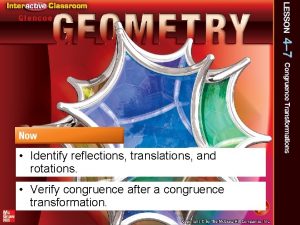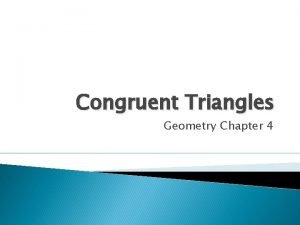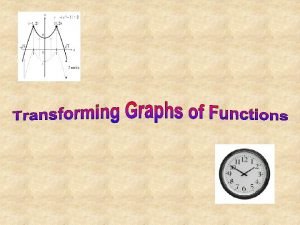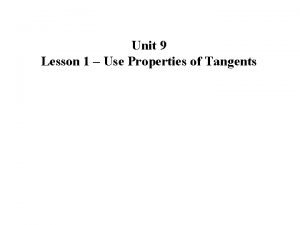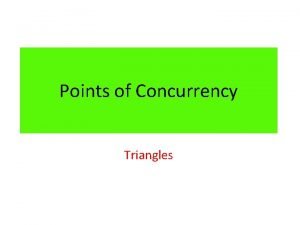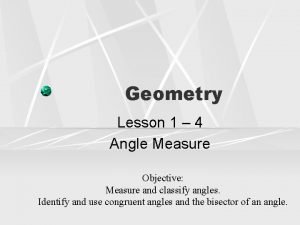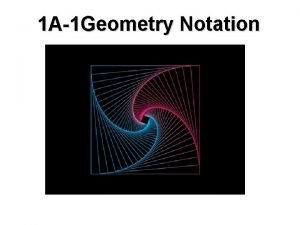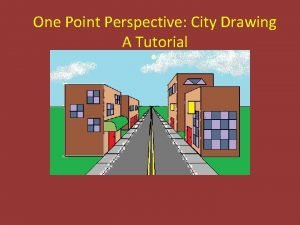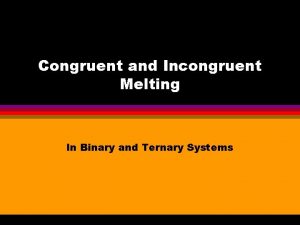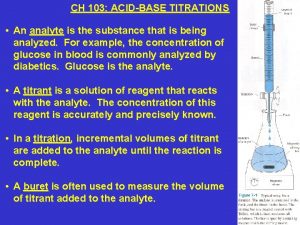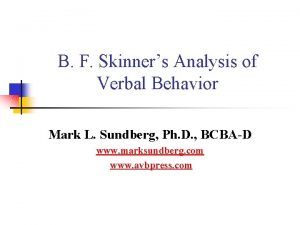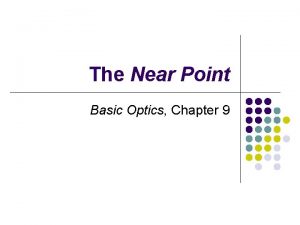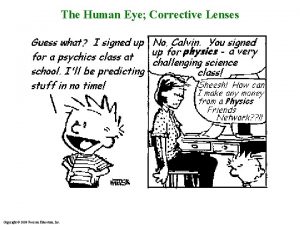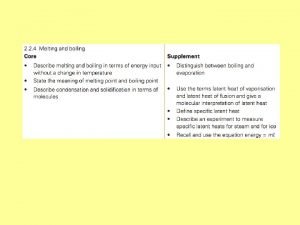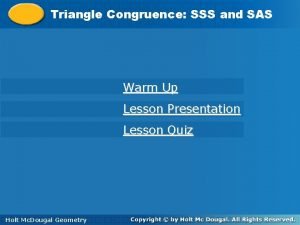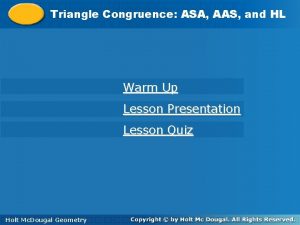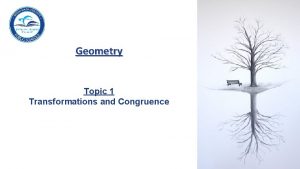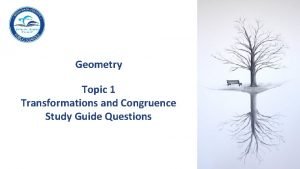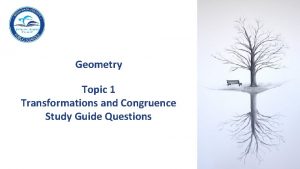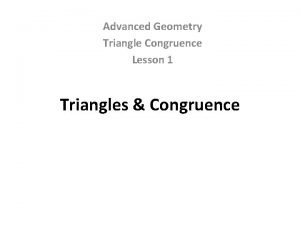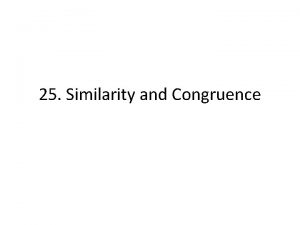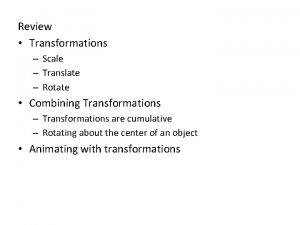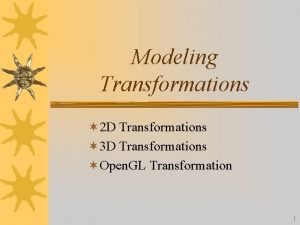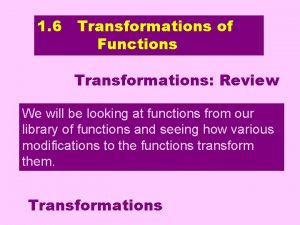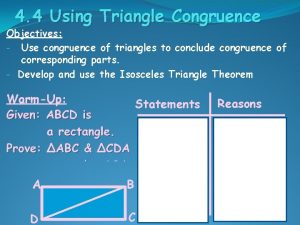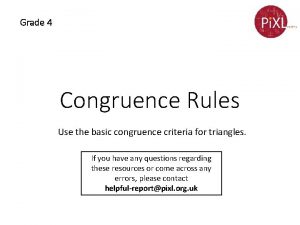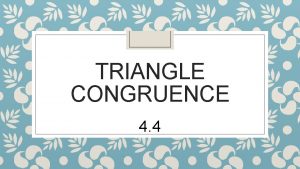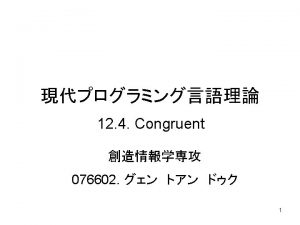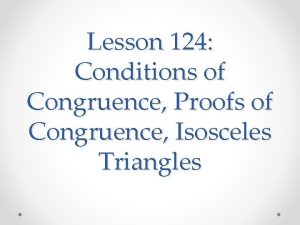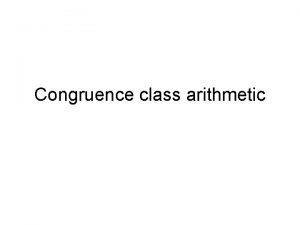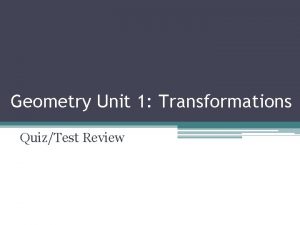Geometry Topic 1 Transformations and Congruence Point a


































- Slides: 34

Geometry Topic 1 Transformations and Congruence

Point – a point has no dimension. It is a location on a plane. It is represented by a dot.

Line – a line has one dimension. It is an infinite set of points represented by a line with two arrowheads that extends without end.

Plane – a plane has two dimensions extending without end. It is often represented by a parallelogram.

Line segment – a line segment consists of two endpoints and all the points between them.

Ray – a ray has one endpoint and extends without end in one direction. Note: Name the endpoint first. BC and CB are different rays.

Collinear – points that lie on the same line. K, L and M are collinear points.

Coplanar – points that lie in the same plane.

Midpoint - divides a segment into two congruent segments.

Angle – a figure formed by two rays with a common endpoint.

Vertex – the common endpoint of two or more rays or line segments.

Side of an angle – one of the two rays that form an angle.

Complementary angles – two angles whose measures have a sum of 90°.

Supplementary angles – two angles whose measures have a sum of 180°.

Transformation – a change in the position, size, or shape of a figure. A transformation maps the preimage to the image.

Rigid motion– a transformation of the plane or space, which preserves distance and angles.

Translation - a transformation in which all the points of a figure move the same distance in the same direction; the figure is moved along a vector so that all of the segments joining a point and its image are congruent and parallel. Preimage A(1, 2) B(3, 2) C(4, 3) D(3, 4) E(1, 4) Image A (-2, -3) B (0, -3) C (1, -2) D (0, -1) E (-2, -1)

Reflection – a transformation across a line, called the line of reflection. The line of reflection is the perpendicular bisector of each segment joining a point and its image. Preimage D (1, -2) E (3, -2) F (3, 2) Image D (-1, -2) E (-3, -2) F (-3, 2)

Rotation – a transformation about a point P, also known as the center of rotation, such that each point and its image are the same distance from P. All of the angles with vertex P formed by a point and its image are congruent. Pre-image has been transformed by a 90° clockwise rotation about the origin. Preimage A (-3, 0) B (-3, 3) C (-1, 3) D (-1, 0) Image A (0, 3) B (3, 3) C (3, 1) D (0, 1)

Symmetry – the transformation of a figure such that the image coincides with the preimage, the image and preimage have symmetry.

Center of rotation – the point around which a figure is rotated. Pre-image A has been transformed by a 90° clockwise rotation about the point (2, 0) to form image A’.

Postulate – a statement that is accepted as true without proof.

Conjecture – a statement that is believed to be true. Theorem – a statement that has been proven.

Deductive reasoning - method using logic to draw conclusions based upon definitions, postulates, and theorems. Inductive reasoning – method of drawing conclusions from a limited set of observations

Counterexample - specific case for which a conjecture is false. One counterexample proves a conjecture false.

Conditional Statement - a logical argument consisting of a set of premises, hypothesis (p), and conclusion (q).

Segment bisector – a line, ray or segment that divides a segment into two congruent segments.

Angle bisector – a ray that divides an angle into two congruent angles.

Linear pair – a pair of adjacent angles whose non-common sides are opposite rays.

Parallel lines – lines in the same plane that do not intersect.

Perpendicular lines – lines that intersect at 90° angles.

Perpendicular bisector - a segment, ray, line, or plane that is perpendicular to a segment at its midpoint.

Line of Symmetry – a line that divides a figure into two congruent reflected halves.

Rotational symmetry – a figure that can be rotated about a point by an angle less than 360° so that the image coincides with the preimage has a rotational symmetry.
 Geometry topic 1 review
Geometry topic 1 review Congruent segments
Congruent segments 4-1 congruence
4-1 congruence Identify the type of congruence transformation?
Identify the type of congruence transformation? How to verify a congruence transformation
How to verify a congruence transformation Geometry chapter 4 proving triangle congruence
Geometry chapter 4 proving triangle congruence Multiple transformations geometry
Multiple transformations geometry Clincher sentence examples
Clincher sentence examples Narrowed down topic
Narrowed down topic Theory of structures
Theory of structures Electron domain geometry vs molecular geometry
Electron domain geometry vs molecular geometry The basis of the vsepr model of molecular bonding is
The basis of the vsepr model of molecular bonding is Hub and spoke system advantages and disadvantages
Hub and spoke system advantages and disadvantages Point evidence explanation paragraph examples
Point evidence explanation paragraph examples Hindi presentation topics
Hindi presentation topics Common internal tangent
Common internal tangent Converting point slope to slope intercept
Converting point slope to slope intercept Concurrency triangle
Concurrency triangle Geometry lesson 1-4 angle measure answers
Geometry lesson 1-4 angle measure answers Basic geometric figures lesson 1-1
Basic geometric figures lesson 1-1 Proper notation geometry
Proper notation geometry Block organization vs point by point
Block organization vs point by point Bubble point formula
Bubble point formula Point of difference and point of parity
Point of difference and point of parity One point perspective drawing of a city
One point perspective drawing of a city Congruent and incongruent melting point
Congruent and incongruent melting point Difference between endpoint and equivalence point
Difference between endpoint and equivalence point Point to point correspondence and formal similarity
Point to point correspondence and formal similarity Far point near point
Far point near point Far point near point
Far point near point Astm d6045
Astm d6045 Boiling point and melting point
Boiling point and melting point 4-5 triangle congruence sss and sas
4-5 triangle congruence sss and sas Hl congruence
Hl congruence Sss sas asa aas
Sss sas asa aas
